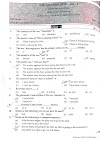Centre of mass
The centre of mass of a body is a point where the whole mass of body is supposed to be concentrated.
If all the forces acting on the body were acting on the body were applied on centre of mass, the nature of motion of body shall remain unaffected.
The coordinates of CM for a two particle system can be written as:
and
and are the coordinates of and
Also,
Distance of CM from is
And from is
Where is distance between two particles having mass and .
Moment of inertia (I)
Moment of inertia of a body about a given axis is the property by virtue of which, the body opposes any change in its state of rest or state of uniform rotation about that axis.
-It plays same role in rotational motion as mass does in translation motion.
-It is scalar quantity.
-It depends upon mass and size of body & distribution of mass about axis of rotation.
MOI is formulated as,
• For a single particle, (m is mass of particle and r is its distance from axis of rotation)
• For large number of particles in a body,
-It is the perpendicular distance of a point from axis of rotation at which whole mass of a body is concentrated. It can be given as ;
-K depends upon axis of rotation.
Note: Numerically, = coefficient of
Theorems
- Parallel axis theorem
According to this theorem, the MOI of any body about any axis parallel to axis through centre of mass is equal to sum of MOI about axis through centre of mass and product of mass and square of distance between two axis.
i.e.
Here, is MOI about axis through centre of mass and is MOI about axis parallel to it.
According to this theorem, the MOI of plane lamina about an axis perpendicular to its plane is equal to sum of its MOI about any two mutually perpendicular axes chosen on lamina through same point.
i.e.
either,
or,
or,
Moments of Inertia for Different Objects
- For Rod

- For Sphere

- For Hoop

- For Cylinder

- For Ring/Disc

Kinetic Energy of a rotating body and rolling body
For rotating body,
For rolling body (without sliding),
Rolling (without sliding) of a body down an inclined plane from rest
- Velocity at bottom
- Acceleration down the plane
Note:
Here, and are velocity and acceleration for that body when it slips/slides from rest along smooth inclined plane from rest from the same height. Also, ø is angle of inclination of inclined plane.
- Time to reach bottom (time of descent)
- Frictional force and coefficient of friction
……. (i)
…………… (ii)
From (i), …… (iii)
Also, for no sliding,
from (ii) and (iii)
Hence,
Angular momentum and Torque
Torque due to a force is moment of force and measures turning effect of force about axis of rotation. Its general expression is, =r x F
Also, Torque= dL/dt
Angular momentum of a particle about a given axis is the moment of linear momentum of the particle about axis.
Its general expression is L = r x p
Couple
When two equal and parallel forces act opposite to each other having a different line of action, then they both create a couple.
Application of Couple
Steering wheel applied by the car driver
Opening and closing of a water tap
Winding the spring of an alarm clock
Unlocking the locker by using a key
Opening and closing of a cap of a water bottle, or jug.
Turning of a screwdriver
Conservation of angular momentum
If external torque acting on a body is zero, its angular momentum remains constant. Mathematically,
constant
i.e.
Conservation of angular momentum shows that increase in speed of rotation decreases MOI and vice versa
Note: Rotational collision can be linked to translation collision as well. We apply conservation of translation momentum in translational collision. Likewise, we apply conservation of rotational momentum in rotational collision.
Application
Ballet Dancer
Ice skater
Revolution of planet around sun.





.png)


.png)
0 Comments